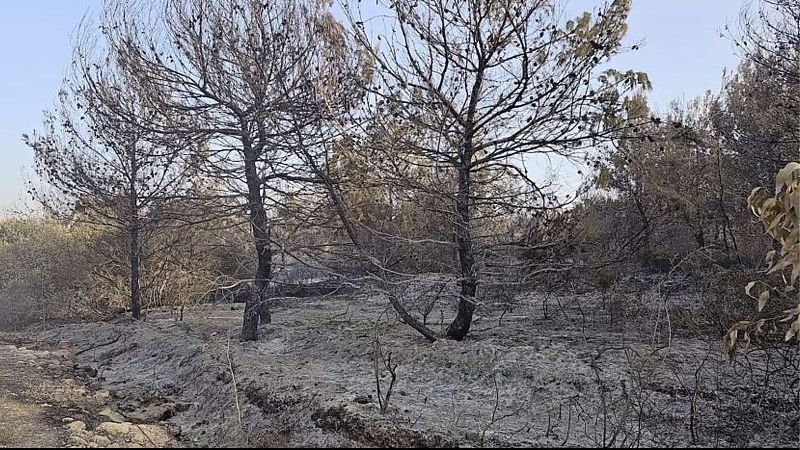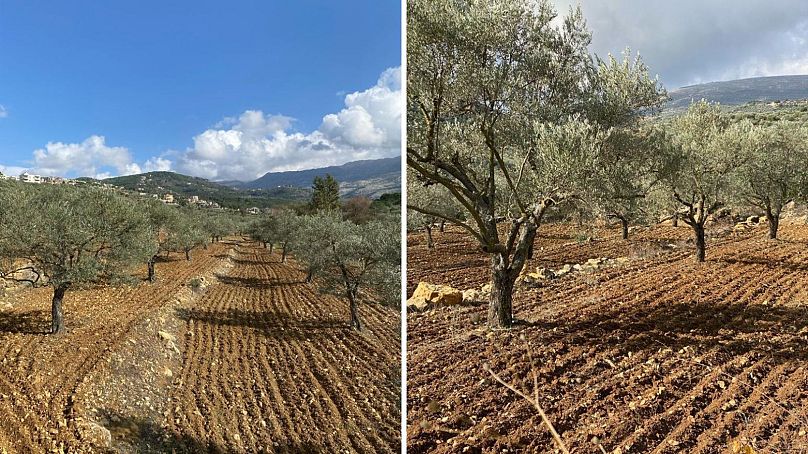Lebanon's olive groves and water table contaminated by Israeli munitions

Ali Al-Sha’ar, a farmer from southern al-Hebbariyah in Lebanon, refused to abandon his land even as neighbours fled and airstrikes shook the ground around him.
For nearly 14 months, he ploughed his fields under the shadow of war; the distant boom of explosions a constant reminder of the danger.
Now, with a fragile ceasefire in place, the immediate threat has lifted. But his once-thriving crops lie scorched, withering under a layer of dust and debris.
Over the past year, war has raged in Lebanon between Israel and Iran-backed Hezbollah, driven by the latter’s support for Hamas after its brutal attack on 7 October 2023. A ceasefire then took effect in late November, following relentless Israeli shelling of southern Lebanon and Beirut.
The conflict has worsened Lebanon's already severe environmental crisis, which stems from years of corruption and poor governance, sparking fear over Lebanon's ability to meet local food needs, according to the country’s National News Agency (NNA).
The conflict has left agriculture in ruins
After the Israeli Defence Forces (IDF) dropped thousands of tonnes of munitions on southern Lebanon - including internationally banned white phosphorus - its agricultural sector, which accounts for as much as 80 per cent of local GDP, was left in devastation.
More than 37 villages, farms, and orchards were destroyed during the violence.
“The olive harvest season coincided with the escalation of the conflict, preventing many people from reaching their orchards,” says Hussein Ismail, former president of the Olive Oil Press Owners Association in the south.
Entire groves were burned due to phosphorus and incendiary bombs, according to Ismail, whose association estimates the loss at 80 per cent across all regions.
"These trees will need several years to recover," Ismail adds. “Most trees were destroyed or burned in villages along the frontlines, while others shed their fruit prematurely, leaving the olives to spoil.”
In areas like Maimes, Hasbaya district, where 90 per cent of the land is devoted to olives, farmers harvested early due to fears of escalating violence despite being spared direct bombing.
According to Wahib Madi, head of the Maimes Agricultural Development Cooperative, the abrupt harvest caused a 20 per cent reduction in olive oil production.
Across the region, the impact extends beyond olive production. Farmers along the Hasbani River cultivated only about 20 per cent of their land, resulting in further vegetable and fruit crop losses.
For farmers like al-Sha’ar, the challenges have been relentless.
“Due to the threat, we only worked for a few hours most days,” he says. “In a plot in Shebaa, my friend and I grew cauliflower and cabbage, but airstrikes destroyed the entire harvest. I lost at least $10,000 (€9,500).”
His apple and cherry crops in Mount Sadaana suffered a similar fate as airstrikes made harvesting impossible.
Lebanon’s forests under threat
The environmental toll of the conflict stretches beyond agriculture into forests and public health, raising alarms among experts.
According to George Metri, director of the Land and Natural Resources Programme at the University of Balamand, fires caused by war have ravaged thousands of hectares of greenery.
“Our initial 2024 survey shows 5,745 hectares burned, including 2,165 hectares of forests and 908 hectares of agricultural land,” he says.
Hala Kilani, president of environmental organisation IndyACT, describes the devastation as both “immediate and long-term.”
“Over five million square metres of forested land, home to unique biodiversity, have been burned. These ecosystems are vital for climate mitigation and sustaining life across generations," Kilani says.
Infrastructure damage and environmental pollution are exacerbating the situation, according to Jalal Helwani, director of the Environmental and Water Sciences Laboratory at the Lebanese University. He notes that Lebanon's water crisis, already a pressing issue in peacetime, has been "compounded" by the ongoing war.
Lebanon’s water supply faces collapse
“Lebanon does not have a water surplus,” Helwani explains. “While we receive significant rainfall, poor water resource management has undermined our ability to benefit from it fully.”
The country's water woes are caused by decades of poor storage infrastructure, resulting in the depletion of groundwater, especially in coastal areas. “In these regions, pumping water to meet the growing population’s needs has increased salinity levels,” Helwani says.
The war further strained these resources by destroying critical water infrastructure, including networks and reservoirs. Toxic chemicals from banned weapons, such as phosphorus and lead, have polluted the environment as rainfall carries pollutants deeper into groundwater supplies.
“Environmental pollution in Lebanon is multifaceted, but water pollution is the most dangerous. It poses significant challenges in securing drinking water, rehabilitating networks, and restoring infrastructure, which would be costly and time-consuming,” adds Helwani.
He warns of a looming social crisis when displaced populations return to areas with destroyed infrastructure and water contamination.
Fog hung over Beirut
Najat Aoun Saliba, an MP and atmospheric chemistry expert, is spearheading efforts to understand the impact of war-related pollutants on public health.
“We are currently conducting a study at the American University of Beirut that focuses on pollutants generated by diesel generators and the chemicals in munitions used during the conflict,” she says, noting that generators, often used due to lack of electricity, produce toxic emissions.
Combined with debris from airstrikes and other war-related activities, these emissions created a persistent black fog over the capital.
“It’s a cocktail of harmful minute particles like dioxins, polycyclic hydrocarbons, and formaldehyde,” Saliba says, noting that the fog contains toxic particles, heavy metals, rocket fuel by-products, and emissions from burning plastic and other materials.
Echoing Saliba’s concerns, Kilani notes that wars also generate significant greenhouse gases that are rarely accounted for, criticising the global blind spot regarding military emissions.
According to Saliba, prolonged exposure to these pollutants, over fifty consecutive days in some areas, posed serious health risks. She warned that the contaminants can penetrate the skin and affect all organs, advising residents to take precautions by removing clothes upon entering the home, showering, and cleaning living spaces with soap and water.
Lebanon's Ministry of Environment has started soil sampling to assess pollution from phosphorus bombs and other munitions, according to Mohammad Al-Abyad, advisor to the minister.
While winter rains may lower air pollution, the country’s air quality monitoring system requires reactivation, a goal the ministry is pursuing with the World Bank and UNDP.
“The destruction wrought over the past year will take decades to heal,” says Kilani. “Ecosystems have been disrupted, forests decimated, and soil and water contaminated. Recovery will require long-term, coordinated efforts to restore biodiversity, rehabilitate farmland, and address pollution - challenges compounded by Lebanon’s existing economic and infrastructure crises.”
This article is published in collaboration with Egab.
Yesterday


